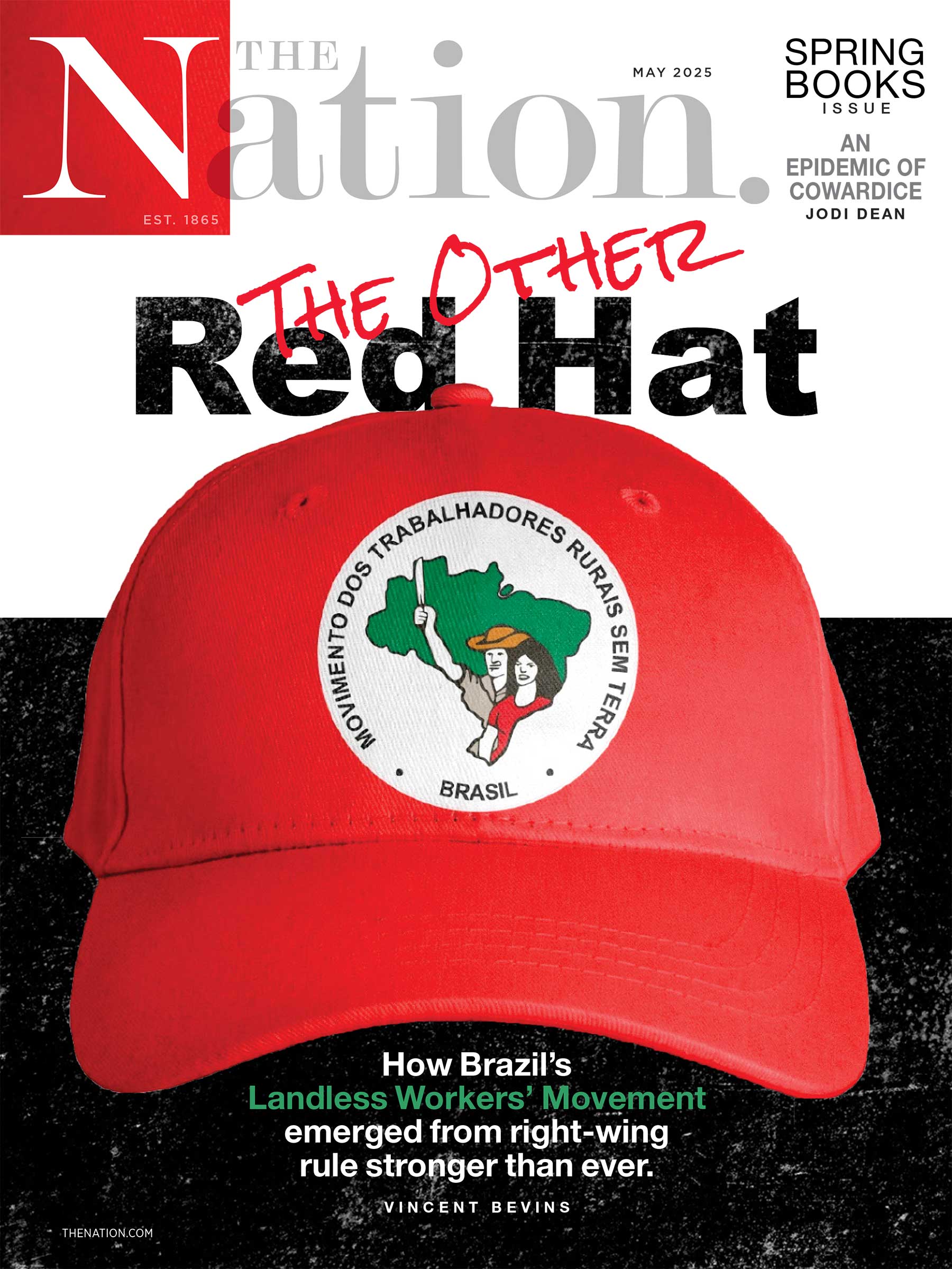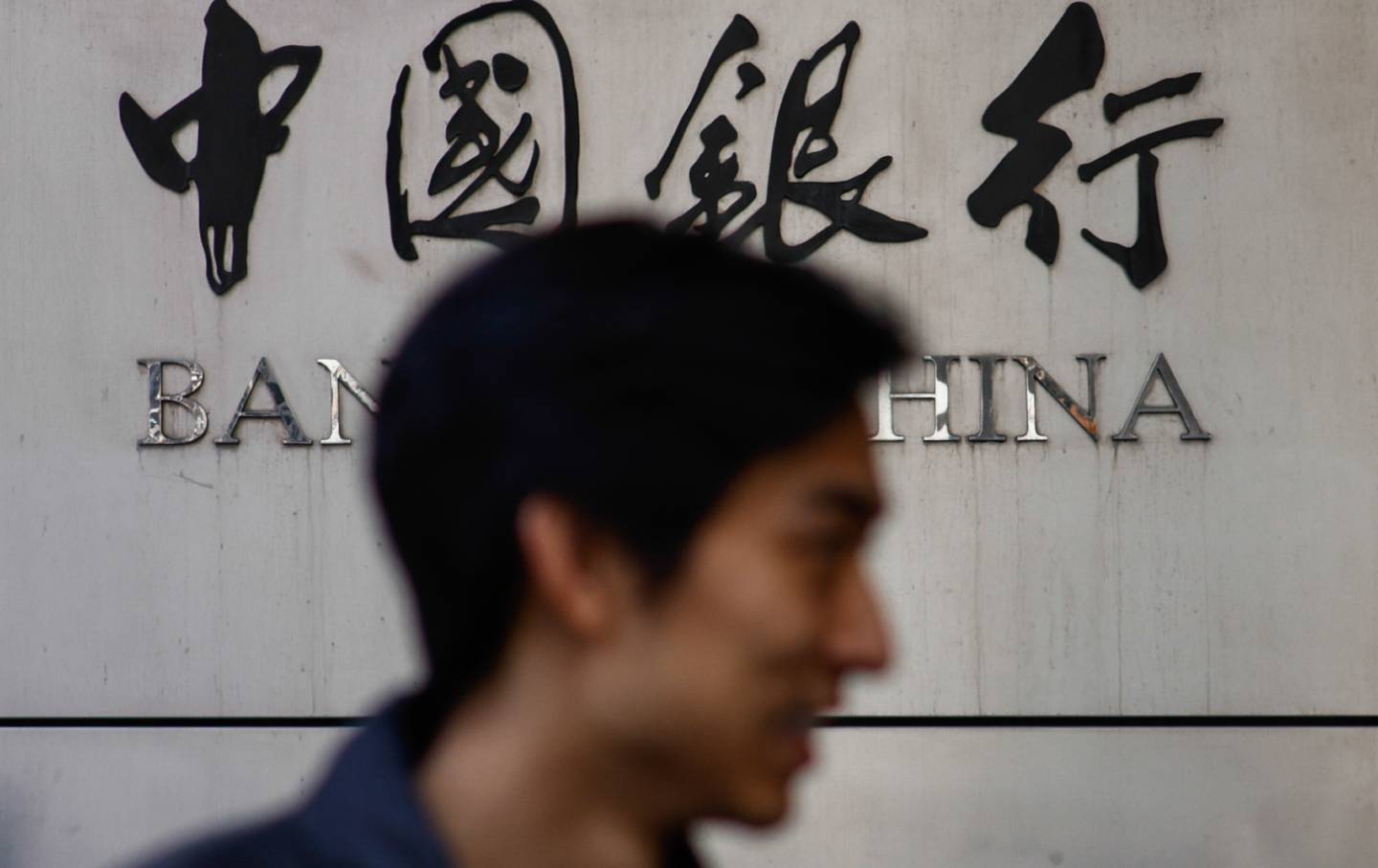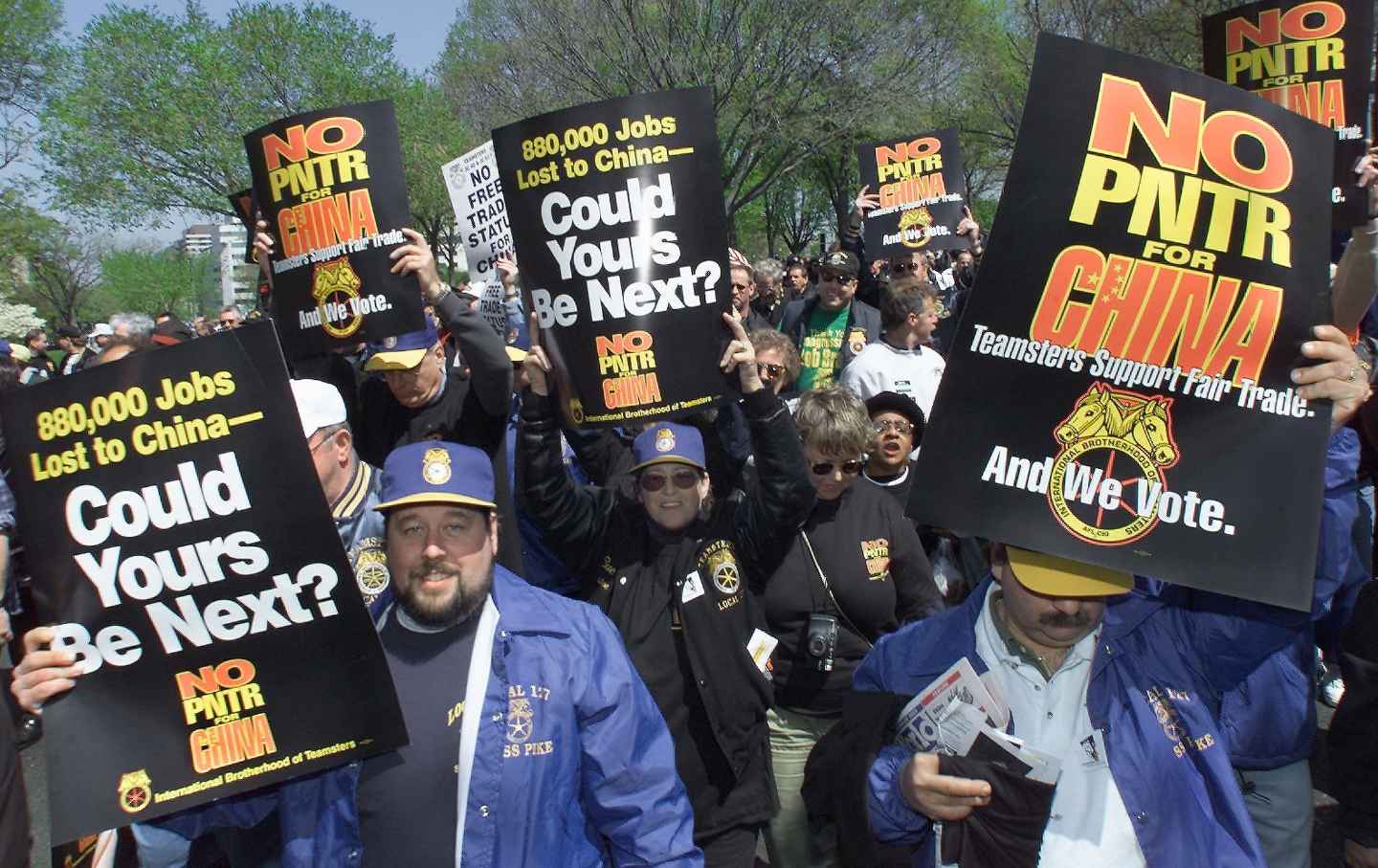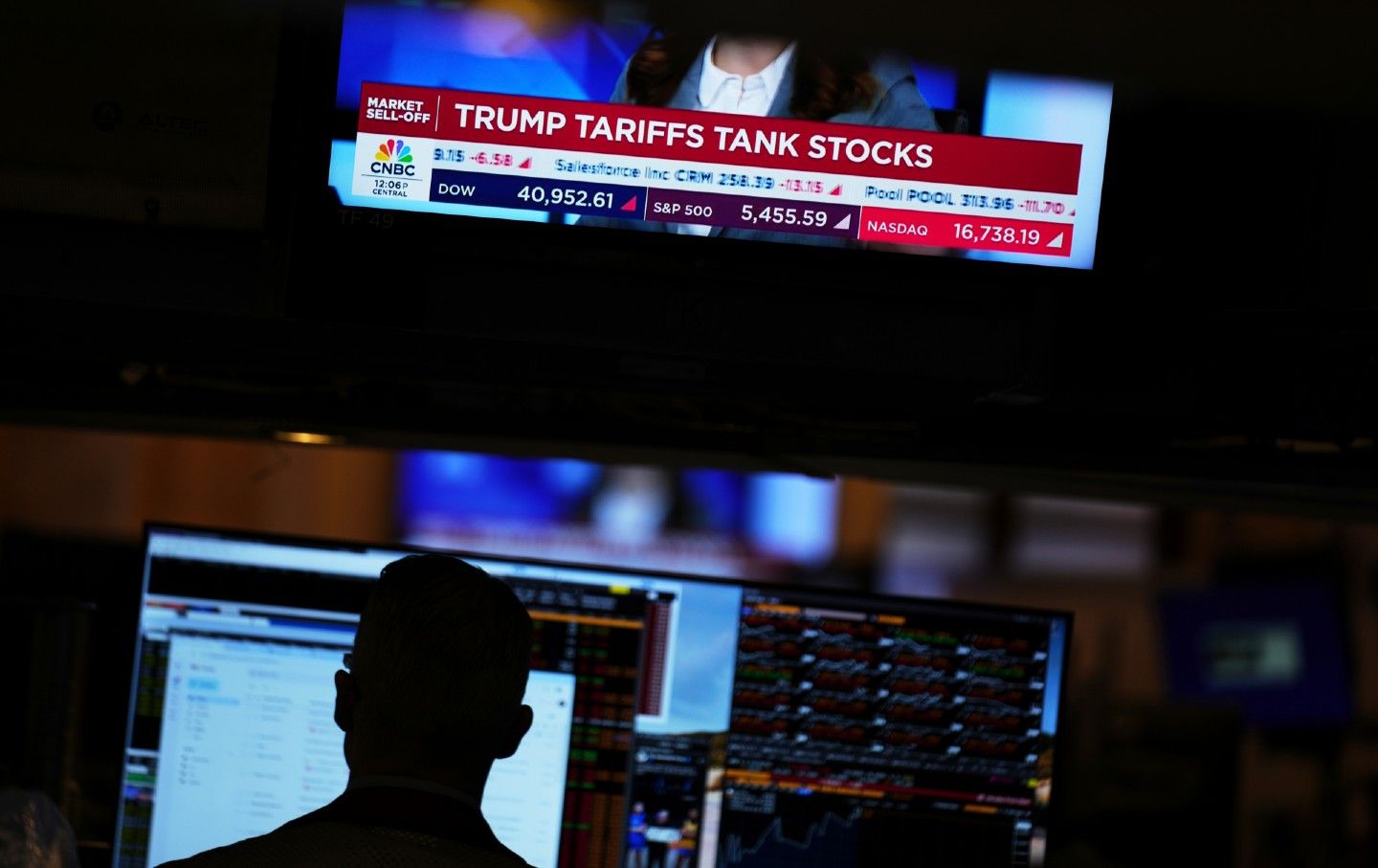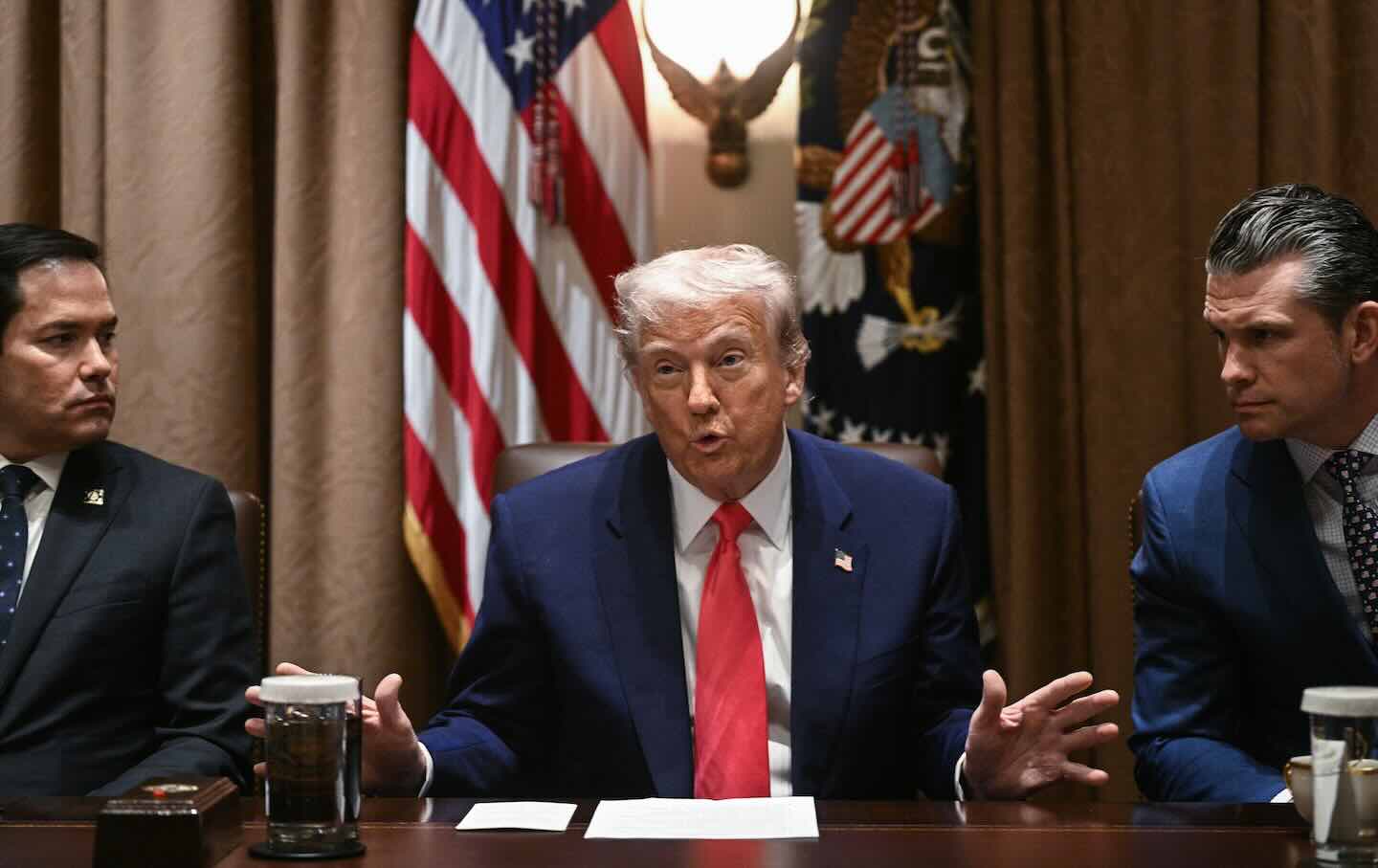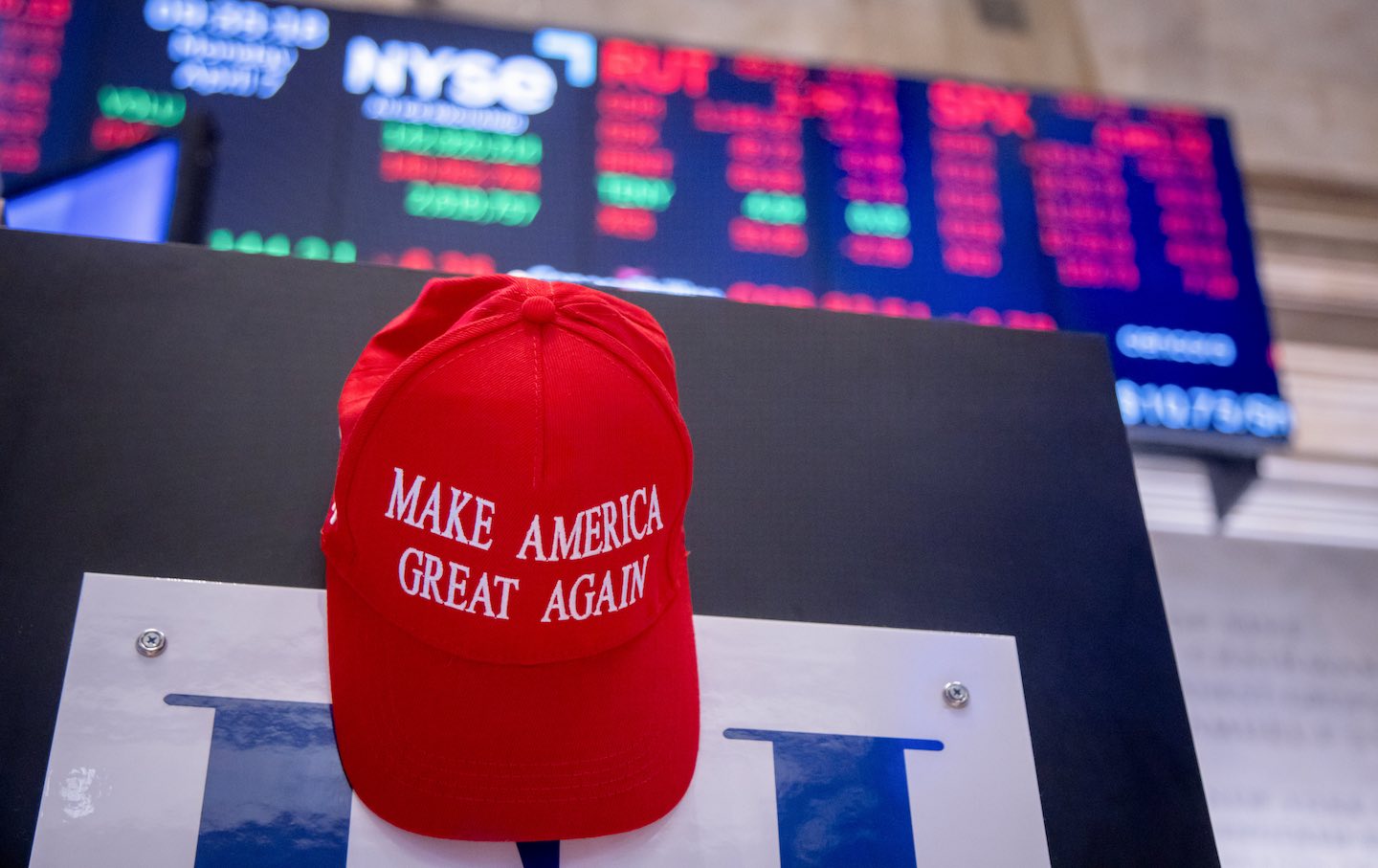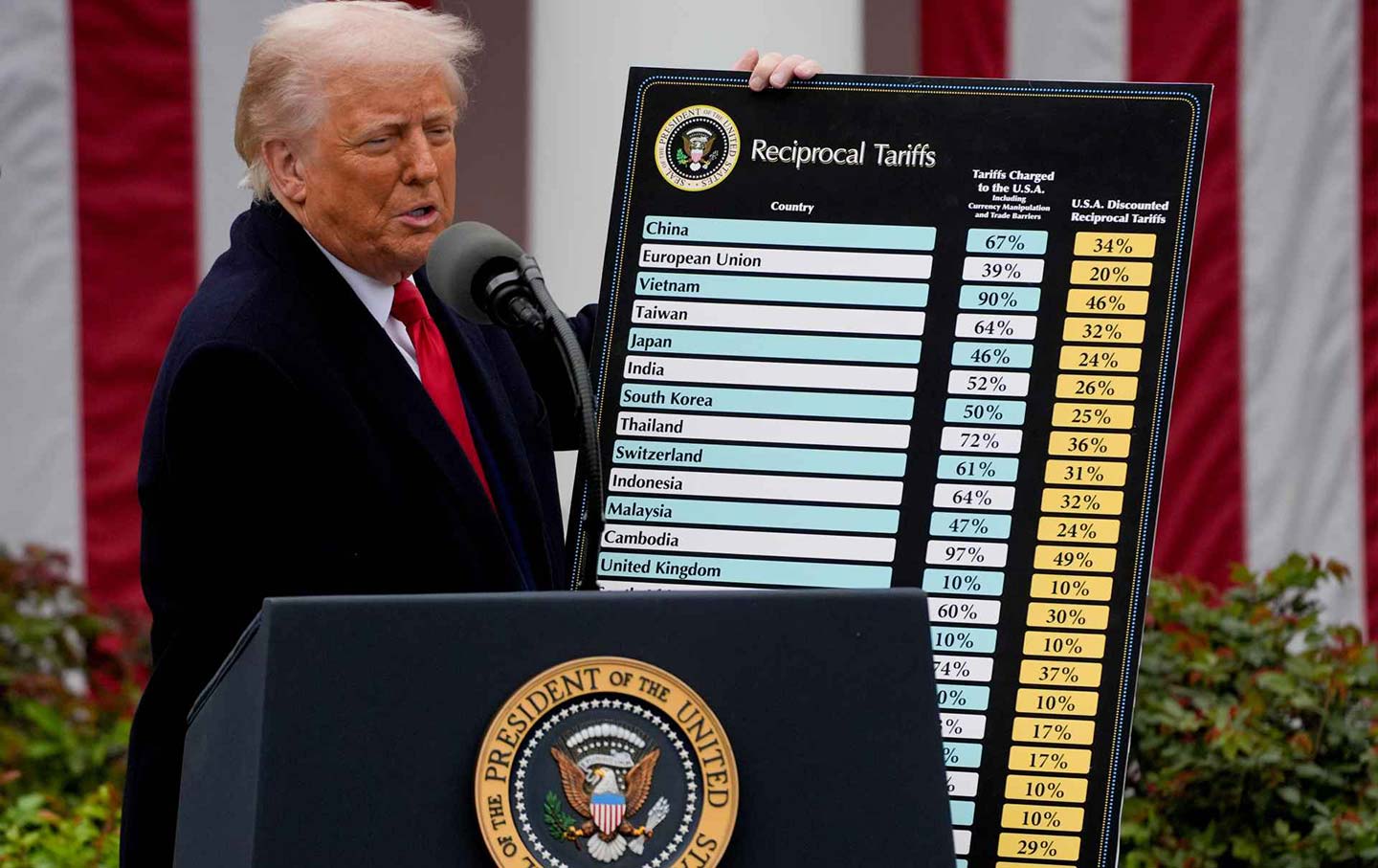Shawn Fain Is Right. America Needs to Rethink Trade.
Trump’s tariff war is chaotic, but there is no way out of neoliberal globalization without some form of protectionism.
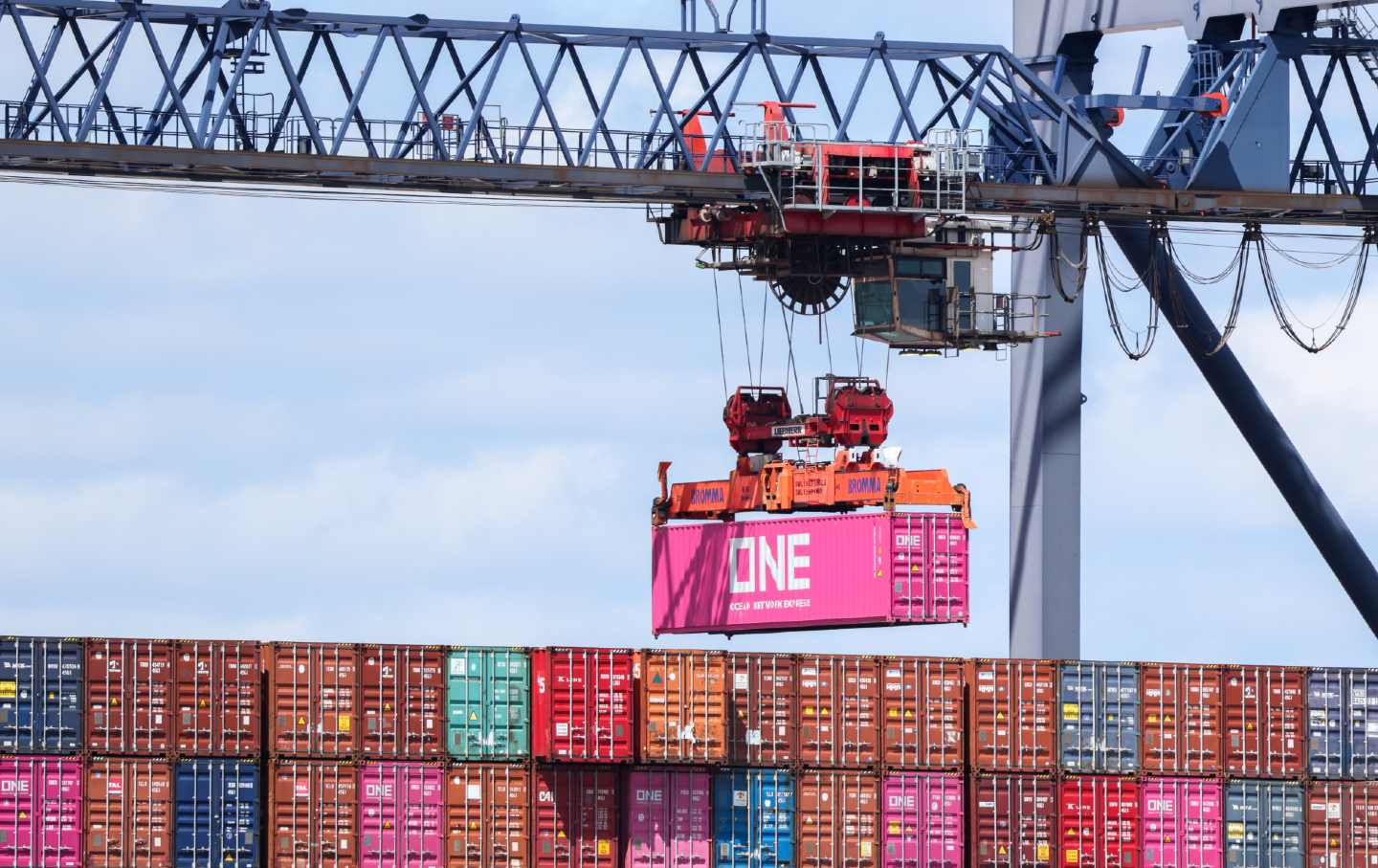
A shipping container is moved at the Port Jersey Container Terminal in Jersey City, New Jersey on April 8, 2025.
(Charly Triballeau / FP via Getty Images)
United Auto Workers (UAW) president Shawn Fain has many liberals scratching their heads. The longtime critic of Donald Trump who wore a “TRUMP IS A SCAB” T-shirt at the Democratic National Convention last year has come out in support of the president’s favorite economic policy: tariffs. Despite the fact that other leading progressives have expressed extreme alarm at Trump’s plans, Fain has insisted that tariffs are “a tool in the toolbox…to bring jobs back here, and, you know, invest in the American workers.”
He’s right, and he’s not alone in thinking this. A group of self-proclaimed “economic patriots” on the left are making a similar case in Congress. Representative Chris Deluzio, a Democrat from Western Pennsylvania who won election in the state’s most competitive district, recently took to The New York Times to plead with his party not to embrace “anti-tariff absolutism” as a response to Trump’s policies. And Representative Jared Golden, a Democrat from a rural Trump-leaning district in Maine, recently made a similar case, arguing, “Tariffs are a first step in rewriting a rigged trade system.”
Tariffs are part of any sound trade policy. The way they work is simple: By raising the prices of foreign goods, you make domestic goods more attractive to domestic consumers, thus increasing demand and expanding homegrown production.
Of course, Trump’s tariffs are erratic, and their intended purpose is unclear. They will likely do more harm than good. But that doesn’t mean protectionism is inherently a bad idea. In fact, if the left cannot offer a compelling exit from neoliberal globalization, it will be unable to effectively combat the GOP’s national populism with a social populism of its own. Rethinking trade must be a central part of a pro-worker agenda.
NAFTA Wrecked Everything
For many union members, the North American Free Trade Agreement (NAFTA) marks the beginning of US decline. The agreement made it so that money, goods, and labor could flow more freely across the continent. Since it was enthusiastically signed into law by President Bill Clinton in 1993, manufacturing jobs have drained out of the United States to lower-wage corners of the globe. And NAFTA wasn’t even the worst of it; a succession of trade deals followed, including the admission of China into the World Trade Organization. This led to a collapse of manufacturing jobs in the United States.
In the 30 years since, around 90,000 US manufacturing plants have been shuttered. The impact on the labor movement has been disastrous. In 1990, around 20 percent of workers in the US belonged to a union; by 2024 that rate had plummeted to around 9 percent, a record low. The decline of manufacturing and union density combined with looser border restrictions that invited hyper-exploited foreign-born workers into the United States have crushed wages, which have been stagnant for non-college-educated workers.
By swapping high-wage often union jobs in manufacturing, for low-wage nonunion jobs in services, free trade has effectively robbed the working class of its social, political, and economic power.
Few industrial unions have been as affected as the UAW. Since the 1990s, the autoworkers have witnessed over 60 major plant closures among the Big Three automakers. Membership in the union peaked at around 1.5 million in 1979. Today, the UAW has around 390,000 members—a 74 percent decrease. Worse, even when the union manages to make inroads in new plants, companies always have an exit option. They can pack up and relocate to places where labor is cheaper.
What’s more, layoffs and plant closures have had a devastating effect on the towns and cities that depended on industrial wages and investments. While some economists insist that job losses in manufacturing have been offset by the arrival of cheap goods from China (and ever-rising stock prices), they discount the devastating social, psychological, and political effects of plant closures. The mounting “deaths of despair” and rise of opioid addiction, concentrated in working-class former industrial cities and towns, indicate a social rot that began with the country’s embrace of free trade.
Politically, despite Bill Clinton’s and Barack Obama’s confidence that a super-charged global “knowledge economy” would generate broad-based prosperity that would reward progressives, the results have not been good for Democrats. In fact, as wages stagnated, working-class voters have drifted away from the party. No Democratic candidate for president has ever matched Bill Clinton’s level of support with these voters. Lyndon Johnson feared that he lost the South for a generation by passing civil rights laws, but liberals seem unaware that by signing NAFTA, Democrats did the same for blue-collar workers. Obama even tried to deepen the disaster with the Trans-Pacific Partnership, which was never ratified.
By 2016, the populist backlash had arrived. Both Donald Trump and Bernie Sanders slammed the establishment for disastrous trade deals. And both won a larger share of working-class voters than their establishment counterparts. And the United States wasn’t alone. A recent meta-analysis by political scientists, led by Gábor Scheiring at Georgetown University, found that the surge in populism all over the world is driven by a reaction against the insecurity induced by globalization. While debate remains over whether workers were driven away from the left because of economic issues or cultural ones, with globalization the two phenomena are linked—the same market forces that drove manufacturing to extinction also helped to drive the increasing pace of cultural churn.
Of course, globalization didn’t only generate losers. Skilled professionals have done well under free trade. Those with advanced degrees plugged into the knowledge-city hubs that dot the globe have seen salary increases over the last 30 years, and they’ve reaped significant consumer rewards as well, from the arrival of cheaper foreign goods to the arrival of cheaper foreign labor, like nannies and maids. One consequence of their relative economic success, however, is that the educated middle classes have pulled away from the working class socially, politically, and culturally. Ironically, as the white-collar class became more liberal, they became less aware of the economic interests or aspirations of their blue-collar counterparts—which explains their constant exasperation that someone of modest means might vote for Trump.
Not only this, but because of the nature of their work, professionals maintain effective control of the means of cultural production, and they’ve, perhaps unwittingly, imposed their own aesthetic and cosmopolitan tastes on the broader public. One way to think of the culture wars is as a process of elite cultural reeducation. The academy, the media, and the sprawling nonprofit industrial complex has, since the 1990s, insisted upon new ways of speaking, writing, and thinking that quickly become litmus tests for whether one is considered moral by the liberal literati. This process has only exacerbated working-class resentment: Not only has globalization not worked out for the working class economically, but culturally they’re now expected to ape the values of their social betters.
But none have benefited as much as Wall Street, the über-rich, and the multinational mega-corporations. The wealthy reap rewards on both sides of the globalization gambit. They rake in record profits off cheap labor in foreign countries where unions and workplace rights are weak or nonexistent. And they benefit from the privileged position the new global order affords them. The freedom to invest and divest in whatever country they choose gives the rich immense power over the world’s poor, whose governments clamor to attract new investment by depressing wages and promising investors freedom from taxes and regulation. The result is that the rich have grown much richer. In 1990, CEOs made roughly 76 times what their typical employee made, by 2023 that number grew to 290 times. Over the same period, the number of billionaires in the United States has grown by more than 1,000 percent. Since 2024 their wealth, through the magic of finance, has grown by $3.9 trillion. These numbers are mind-boggling, but as Labor Institute director Les Leopold usefully put it: “If you earned $1,000 per hour, it would take you 68.5 years to reach $1 billion.” Put another way, you don’t earn a billion dollars. You steal it.
What’s been the upshot for the economy overall? Nothing great. As the population of billionaires ballooned, the high growth rates promised by free-trade enthusiasts never arrived. Larry Summers, once an economic adviser to the hyper-globalizing Clinton administration, has recently expressed doubt in the possibility for renewed global growth. Superrich people, it seems, are far more likely to save their money than plow it into engines of economic dynamism. Meanwhile, the rest of us don’t have adequate wages to spend. The suppression of mass demand means that, as The Wall Street Journal recently reported, “The U.S. Economy Depends More Than Ever on Rich People.” And all because neoliberal globalization broke the back of labor all over the world. As the German political economist Wolfgang Streeck said, “Without trade unions, no mass purchasing power; without mass purchasing power, no investment.”
And what about Mexico? Some of globalization’s dead-enders insist that without free trade, workers in countries like Mexico would be a lot poorer. But even this seems dubious. For years the unwritten accord with Mexican auto workers was that, while they would have lower wages than their American counterparts, their plants would employ a lot more labor. Wages would be spread around. Yet today high-tech automation imported from all over the globe is employed to displace Mexican workers—a phenomenon known as “premature deindustrialization.” Mexican workers have suffered hyper-exploitation at the hands of foreign multinational corporations for decades, and now those same corporations are laying off the cheap labor they relied on to lay off American workers.
It’s clear, after 30 years, this system isn’t working for the working class.
Pro-Worker Protectionism
This brings us back to Shawn Fain. Fain knows that Trump’s tariffs are dangerous. He knows that chaos creates economic risks. He knows that Trump’s anti-labor record is not going to benefit US or foreign workers. But he also knows that there is a big division in the political and business class right now, and he’s keen to exploit it. Wall Street hates the tariffs; the political establishment hates the tariffs; even Elon Musk seems to hate the tariffs. Trump’s signature economic policy has the potential to crack up his coalition. It’s in moments like these that a new common sense can form.
In some ways the post-globalized order is already here. Global trade has stagnated since the 2008 crisis, and the public has no appetite for another NAFTA-type free-trade agreement. Yet what comes next is uncertain. Right now, in the debate over trade there seem to be only two voices: Wall Street or Trump. Fain offers a better vision than both.
Popular
“swipe left below to view more authors”Swipe →Fain is right when he argues that auto manufacturers can afford to eat the tariffs without passing on price hikes. Consider that, despite labor-saving automation, manufacturers were charging record prices for a new car before tariffs—in some cases 10 points above the general inflation rate. Where is that money going? Into auto-industry profits that have grown over 50 percent since 2019—despite depressed sales. Fain is right that the industry has “excess capacity” and that tariffs “could bring work back in very short order” by reopening recently closed or underutilized plants. And he’s right that tariffs, combined with an effective industrial policy, could boost workers’ wages, not just in the auto industry but across the board. But more than all of this, Fain is right that we need to restore democratic sovereignty over our economy.
The kind of protectionism he envisions has been a “tool in the toolbox” throughout the history of the labor movement. In some ways it’s the foundational idea of progressive economics. Alexander Hamilton, who was so recently the subject of much liberal admiration, was a huge fan of tariffs. So was the most important progressive economist of all time, John Maynard Keynes. And as the Harvard economist Dani Rodrik argues, the major “trilemma” of the free-trade regime is precisely that we cannot maintain “hyperglobalization, democracy, and national sovereignty all at once; we can have at most, two out of three.”
Too many liberals are now rejoicing at Wall Street’s rejection of the tariffs as if “the markets” are a substitute for democratic input. But plunging stocks only prove what we already knew: that high finance is loath to get off the free-trade gravy train. The turmoil itself demonstrates how hard it is to implement any kind of economic control over the financial paymasters, and it will surely signal to many of Trump’s supporters that he is taking on the elite.
It’s right to be clear-eyed about Trump’s recklessness; indeed, Keynes warned that a move away from globalism “should not be a matter of tearing up roots but of slowly training a plant to grow in a different direction.” Trump has no patience for that, but the left can’t fall into the trap of letting Wall Street set the terms of the debate. To match Trump’s national populism, we need a social populism of our own. We should not retreat to advocating for free trade as a response to stock market panic but advance to a conversation about industrial planning. We need a program that seeks to repatriate American finance, claw back the trillions in taxes lost to offshore banking, and reinvest in US jobs.
The tariff is one of the tools we need to rebuild the economy in favor of the working class.
Hold the powerful to account by supporting The Nation
The chaos and cruelty of the Trump administration reaches new lows each week.
Trump’s catastrophic “Liberation Day” has wreaked havoc on the world economy and set up yet another constitutional crisis at home. Plainclothes officers continue to abduct university students off the streets. So-called “enemy aliens” are flown abroad to a mega prison against the orders of the courts. And Signalgate promises to be the first of many incompetence scandals that expose the brutal violence at the core of the American empire.
At a time when elite universities, powerful law firms, and influential media outlets are capitulating to Trump’s intimidation, The Nation is more determined than ever before to hold the powerful to account.
In just the last month, we’ve published reporting on how Trump outsources his mass deportation agenda to other countries, exposed the administration’s appeal to obscure laws to carry out its repressive agenda, and amplified the voices of brave student activists targeted by universities.
We also continue to tell the stories of those who fight back against Trump and Musk, whether on the streets in growing protest movements, in town halls across the country, or in critical state elections—like Wisconsin’s recent state Supreme Court race—that provide a model for resisting Trumpism and prove that Musk can’t buy our democracy.
This is the journalism that matters in 2025. But we can’t do this without you. As a reader-supported publication, we rely on the support of generous donors. Please, help make our essential independent journalism possible with a donation today.
In solidarity,
The Editors
The Nation
